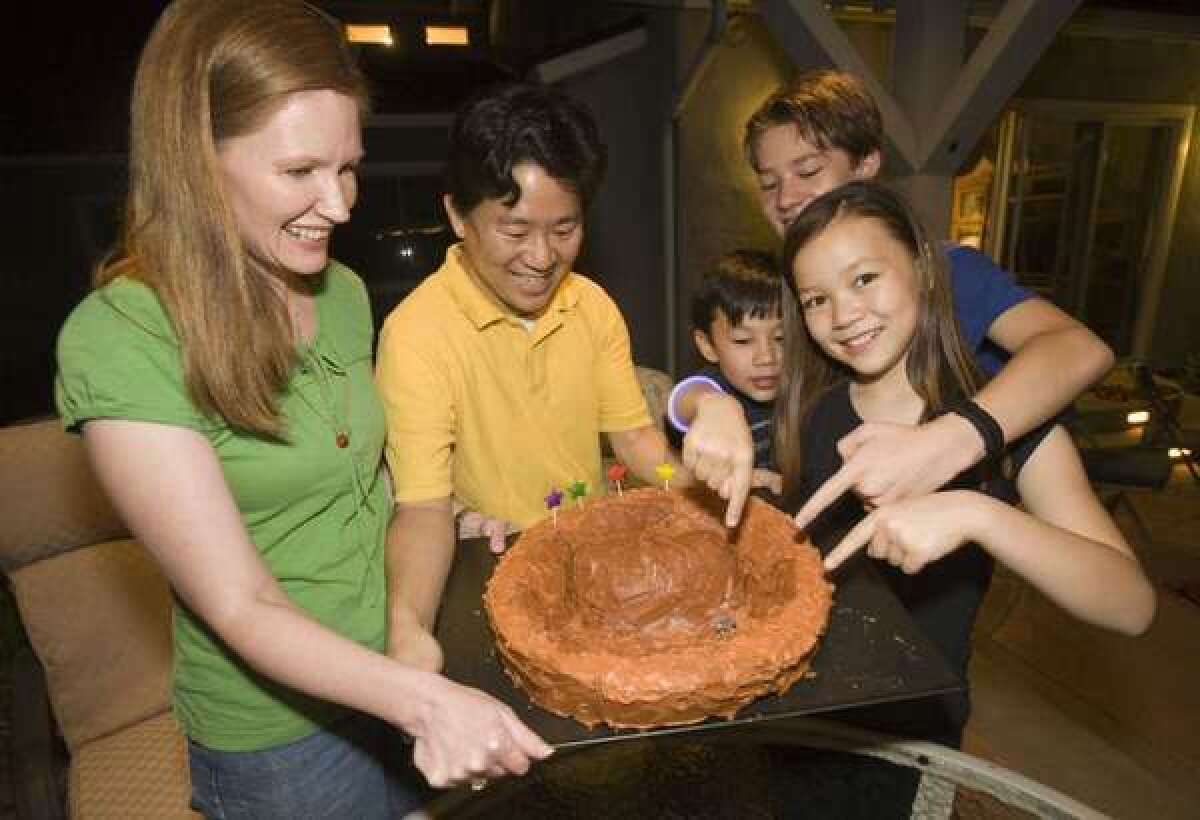Life on Mars time for JPL scientist and his family

- Share via
David Oh’s eldest son taped aluminum foil over his windows. His daughter painted a sign warning visitors away from the front door. His wife pulled the phone cord out of the wall and turned the couple’s cellphones off.
David’s time on Earth had come to a temporary end -- and he was taking his family with him.
As soon as the rover Curiosity dropped onto the Martian surface on Aug. 5, David and hundreds of his fellow scientists and engineers at NASA’s Jet Propulsion Laboratory switched from Earth time to Mars time.
As the lead flight director for the Mars Science Laboratory team, David would sync his life up with the rover’s for the first 90 Martian days of the Curiosity mission. It may not be rocket science, but it’s quite an undertaking.
A Mars day, called a sol, is 39 minutes and 35 seconds longer than a 24-hour day on Earth. That small difference adds up fast, so that noon becomes midnight after 2 1/2 weeks. As scientists wind up sleeping during the day and working through the night, their lives pull away from those of their families.
Not the Oh clan. For the first month, all five have stuck together, an idea championed by David’s wife, Bryn.
“This project for six years has been so much a part of his life,” she said at the family’s tidy two-story home in La Canada Flintridge. “This was a way that I thought that we could be a part of it.”
The family has learned a lot about Southern California since their experiment began, talking to friendly folk in a Canoga Park bowling alley at 4 a.m. and gawking at late-night partygoers while eating dinner at dawn at Fred 62 in Los Feliz.
They’ve discovered the Hollywood sign isn’t lit at night and that the sand on Santa Monica’s moonlit shores is still the perfect temperature for walking barefoot. They’ve noticed that freeway traffic bottoms out at 3 a.m., then starts to pick up again just an hour later.
During one of their frequent late-night walks in the hills near their house, one of the kids saw two shooting stars streak across the quiet sky during the Perseid meteor shower.
--
The idea of working on Mars time goes back to the 1997 Pathfinder mission, which sent the first rover to the Red Planet.
The beetle-like Sojourner rover was designed to skitter around the surface for a week, sending back data once a sol. Members of the Pathfinder team wanted to analyze the results as quickly as possible so they could plan the rover’s next moves. To minimize delays, they decided to work on Mars time too.
Sojourner kept going all week, then continued for a second and a third. The Earthlings did their best to keep up, but after a month they’d had enough.
“The team rebelled,” said Andrew Mishkin, a senior systems engineer on that mission who has endured three stints on Mars time himself. “They were just too exhausted to continue.”
Living on Mars time is like moving two time zones to the west every three days, causing scientists and engineers to feel constantly jet-lagged. That throws off the body’s internal clock, which is synced to a 24-hour day and reset by light and dark.
When that system is out of whack for several weeks, negative effects ripple throughout the body. Metabolism slows, which can cause weight gain. People become less sensitive to insulin, leading to an increased risk for Type 2 diabetes. Some medicines don’t work as well when taken outside the usual circadian window. And in sleep-deprived states, people make more mistakes.
At first, JPL had no formal policies to keep scientists and engineers from working themselves to the edge of their physical limits. They often logged 18 hours a day, and many tried to stick with Earth time when they were off duty, leaving them utterly drained, Mishkin said.
After the Pathfinder mission ended, JPL asked a panel of sleep experts for advice. The key, the experts said, was to keep the body clock on track so that people could sleep during their “night” and stay alert during their “day.”
To do that, the panel recommended that workers stay on Mars time instead of confusing their bodies by toggling between days and sols. They also suggested setting time limits for shifts, limiting caffeine to small doses, and filling the operations rooms with bright light to suppress levels of melatonin, the sleep-inducing hormone, said Dr. Charles Czeisler, a sleep medicine expert from Harvard University who served on the panel.
Not all of the recommendations were adopted. No “solarium” was built to help the engineers adjust, nor was bus transport arranged to and from JPL to keep sleepy workers from getting behind the wheel. But the lab did install blackout curtains to block sunlight in the middle of the Martian night and provide cots for sleepy scientists and engineers whose bodies were having a hard time adjusting to the switch.
--
When veterans of previous Mars rover missions first heard of the Oh family’s plans, they didn’t hesitate to tell David and Bryn they were nuts.
For workers with children, the logistics of living on Mars time are particularly complex: school carpools, sports practice, music lessons and other activities must be accommodated. But that didn’t stop the Ohs.
“I want my kids to have the experience of what it’s like to work on the Mars program,” David said. “Even the youngest understands Dad has a cool job, so for me to kind of disappear on them would be a pity.”
Bryn, like her husband, is an MIT-trained engineer. She’s logged the family’s meals, medical appointments, work shifts and bedtimes on a spreadsheet. She even took a month off from her job as a software training consultant to manage the elaborate Mars-time experiment.
To keep the kids awake when Mars days are Earth nights, she planned a 10 p.m. backyard barbecue, a midnight picnic in Santa Monica and a 3 a.m. run for Krispy Kreme doughnuts.
The first few days seemed charmed. David came home around midnight to a brightly lit house with a cake baking in the kitchen. The kids yelled their greetings when he opened the door.
But a week after the Mars landing, the family started to drag. The kids -- 8-year-old Devyn, 10-year-old Ashlyn and 13-year-old Braden -- struggled to stay awake until sunrise, when it was finally bedtime on Mars.
Their schedules became so misaligned that the family stopped marking their days by Earth time. Instead, they used words like “yestersol” and “solmorrow.”
Even David, whose work and home life are both pegged to the Red Planet, experienced a disconcerting moment when he collected Devyn from a play date around 5 p.m. and asked the friend’s mom if the kids had eaten lunch yet.
“She was looking at me like, ‘Are you crazy?’ ” David said.
The time-traveling adventure kept the family together, but Bryn said she missed feeling connected with the world outside the Mars bubble.
“There’s just an amount of contact you get by being on the road, going grocery shopping, whatever it is,” she said. “I’m a little bit jealous that [David] gets to go into work in the middle of the night and be with people.”
For Bryn and the kids, the hardest part is now over. School started this week -- just as Mars time had cycled around to nearly coincide with the East Coast time zone -- so most of the family is transitioning back to their earthly routines.
“It really felt like we were on vacation, like we really had gone to another place,” Bryn said. “Seeing Los Angeles in a completely different light -- we’re going to miss that.”
The vacation is almost over. Bryn has been watching their time zone edge ever closer to California. On Tuesday, they were lined up with Rio de Janeiro; on Wednesday, New York. On Saturday, they’ll return to Pacific Daylight Time.
“Will miss Orion in the AM,” she wrote on Twitter. “Will miss looking forward to the dawn.”
For two more months, David will soldier on alone.
ALSO:
Looking back: One family recalls living on Mars time
A hunt for dark matter in a former gold mine
Flavor-flipping neutrinos: Key to the Universe’s anti-matter mystery?







